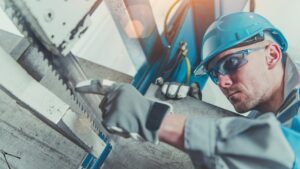Dust extractors are vital tools for keeping workspaces clean and safe. They remove harmful particles from the air, protecting workers.
Work environments can often be filled with dust and debris. This not only creates a mess but can also pose serious health risks. Dust extractors come to the rescue by efficiently capturing and removing dust particles. This ensures a cleaner space and reduces the risk of respiratory issues for workers.
Whether in construction, woodworking, or manufacturing, dust extractors play a crucial role. They help maintain air quality and promote a healthier work environment. In this blog, we will explore how dust extractors work. We will also look at their benefits and why they are essential for any workspace.
Introduction To Dust Extractors
Dust extractors are essential tools in many industries. They remove dust and debris from the air. This helps create cleaner and safer work environments. From construction sites to woodworking shops, dust extractors play a crucial role.
Importance In Workplaces
Dust extractors offer many benefits in workplaces. The most important is air quality. Clean air reduces health risks for workers. Dust particles can cause respiratory issues. Using dust extractors helps prevent these problems.
Safety is another key benefit. Dust can create slipping hazards. Dust extractors help keep floors clear. This reduces the risk of accidents. Productivity also improves in a clean environment. Workers can focus better when dust is controlled.
Evolution Of Dust Extraction Technology
Dust extraction technology has evolved over the years. Early systems were simple. They used basic filters and fans. Modern systems are much more advanced. They use HEPA filters and powerful motors. These features improve efficiency and effectiveness.
Automatic systems are now available. These systems adjust power based on dust levels. This saves energy and reduces wear. Some dust extractors even connect to smart devices. This allows for remote monitoring and control.
The evolution of dust extraction technology continues. New materials and designs are always being developed. These advancements ensure that dust extractors remain effective and efficient.
Types Of Dust Extractors
Dust extractors play a crucial role in maintaining cleaner and safer work environments. They come in various types, each designed to cater to different needs and settings. Understanding these types can help in choosing the right dust extractor for specific tasks. Here, we will discuss two main types: Portable Dust Extractors and Centralized Dust Extraction Systems.
Portable Dust Extractors
Portable dust extractors are ideal for small workshops or job sites. They offer flexibility and ease of movement. These units are compact and lightweight. They are perfect for tasks that require mobility. Below are some key features:
- Compact Size: Easy to move around the workspace.
- Versatile: Can be used with different tools.
- Affordable: Generally less expensive than centralized systems.
- Plug-and-play: Simple to set up and use.
Portable dust extractors are perfect for contractors or DIY enthusiasts. They ensure a cleaner workspace wherever you go.
Centralized Dust Extraction Systems
Centralized dust extraction systems are designed for larger workspaces. They provide a permanent solution for dust control. These systems can handle multiple machines at once. Below are some benefits:
- High Efficiency: Capable of handling large volumes of dust.
- Permanent Setup: Installed in a fixed location.
- Less Noise: Often quieter compared to portable units.
- Low Maintenance: Requires less frequent cleaning.
Centralized systems are suitable for industrial settings or large workshops. They help in maintaining a dust-free environment efficiently.
Both types of dust extractors have their unique advantages. Choose the one that best fits your needs. Whether you need mobility or a permanent solution, there is a dust extractor for you.
Health Benefits
Dust extractors reduce airborne dust, creating cleaner and safer work environments. They help prevent respiratory issues and improve overall health.
Dust extractors play a crucial role in creating cleaner and safer work environments. They help eliminate harmful particles from the air, leading to numerous health benefits for workers. Cleaner air means healthier employees, reducing the risk of various health issues.
Reducing Respiratory Issues
Dust extractors significantly reduce the amount of dust in the air. This helps prevent respiratory problems. Workers inhale fewer harmful particles. Cleaner air means fewer cases of asthma and bronchitis. Regular use of dust extractors leads to healthier lungs. Workers breathe easier and feel better.
Minimizing Allergies And Infections
Dust extractors also minimize allergies and infections. They remove allergens like pollen and mold from the air. Workers experience fewer allergic reactions. Cleaner work environments reduce the spread of infections. Dust extractors help maintain a healthier workspace. Employees feel less sick and more productive.
“`
Safety Improvements
Dust extractors remove harmful particles from the air, creating cleaner and safer work environments. They reduce the risk of respiratory issues and improve overall workplace safety.
Dust extractors offer significant safety improvements in work environments. They help maintain clean air, reducing health risks. They also prevent potential fire hazards. This creates a safer workplace for all employees.
Preventing Fire Hazards
Dust particles can ignite easily. Dust extractors remove these particles from the air. This reduces the risk of fires. In many industries, this is crucial. Manufacturing facilities, woodworking shops, and construction sites benefit greatly.
Enhancing Overall Workplace Safety
Cleaner air means healthier employees. Dust extractors minimize airborne dust. This reduces respiratory issues and allergies. Employees can work comfortably and safely.
Dust extractors also improve visibility. Less dust in the air means clearer sightlines. This reduces accidents and improves productivity. Safety standards increase. Everyone benefits from a cleaner, safer environment.
“`
Efficiency And Productivity
Efficiency and productivity in the workplace are essential for any business. Dust extractors play a significant role in achieving these goals. They ensure a clean environment, which directly impacts the quality of work and reduces downtime. Let’s explore how dust extractors help improve work quality and reduce downtime.
Improving Work Quality
A clean workspace leads to better work quality. Dust extractors remove harmful particles from the air. This results in a healthier environment. Workers can focus better without dust-related distractions.
Also, machinery runs more smoothly. Dust can clog equipment and reduce its efficiency. A dust-free environment ensures machines operate at their best. This leads to higher quality output and consistent performance.
Reducing Downtime
Downtime can be costly. Dust extractors help minimize it. By keeping the workspace clean, they prevent equipment malfunctions. Dust-related breakdowns are less likely, which means fewer repairs and maintenance.
Employees also benefit from reduced exposure to dust. Health issues related to dust inhalation decrease. This leads to fewer sick days and higher attendance rates. A cleaner environment means less time wasted on cleaning and more time spent on productive tasks.

Environmental Impact
Dust extractors play a crucial role in creating cleaner and safer work environments. They not only improve air quality but also contribute significantly to the environment. This section focuses on how dust extractors help in reducing pollution and complying with environmental regulations.
Reducing Pollution
Dust extractors are essential in reducing pollution in workspaces. They capture and filter out harmful particles from the air. This prevents these particles from being released into the environment.
- Cleaner Air: Removing dust particles improves indoor air quality.
- Healthier Employees: Cleaner air means fewer respiratory issues for workers.
- Reduced Emissions: Capturing dust reduces the amount of pollutants released.
By using dust extractors, businesses can ensure a safer and healthier environment for everyone. This also helps in maintaining the natural surroundings cleaner.
Complying With Environmental Regulations
Environmental regulations are becoming stricter. Businesses must comply to avoid penalties. Dust extractors help companies meet these regulations easily.
- Legal Compliance: Using dust extractors ensures businesses adhere to environmental laws.
- Reduced Fines: Compliance helps avoid hefty fines and legal issues.
- Improved Reputation: Companies that comply are seen as responsible and eco-friendly.
By investing in dust extractors, companies not only comply with regulations but also promote a sustainable future. This adds value to the business and the community.
Choosing The Right Dust Extractor
Selecting the right dust extractor is crucial for maintaining a clean and safe work environment. With various options available, it’s important to make an informed decision. This ensures optimal performance and safety.
Factors To Consider
Several factors influence the choice of a dust extractor. Understanding these can help you select the best option for your needs.
- Power and Suction Capacity: Higher power ensures better suction and efficiency in dust removal.
- Filter Type: HEPA filters are highly effective in trapping fine particles.
- Portability: Portable units are ideal for small spaces or mobile workstations.
- Dust Collection Capacity: Larger tanks require less frequent emptying, ideal for heavy-duty work.
- Noise Level: Quieter models are preferable in environments where noise is a concern.
Top Brands And Models
Some brands stand out for their reliability and performance. Here’s a look at some top brands and their popular models.
| Brand | Model | Key Features |
|---|---|---|
| Festool | CT MIDI I | HEPA filter, Compact design, High suction power |
| DeWalt | DWV012 | Automatic filter cleaning, Large tank, Powerful motor |
| Makita | VC4210L | Quiet operation, HEPA filter, High efficiency |
Choosing the right dust extractor involves evaluating your specific needs and the features of available models. This ensures you maintain a cleaner and safer work environment.
Maintenance And Best Practices
Maintaining dust extractors is vital for ensuring cleaner and safer work environments. Proper maintenance and best practices extend the life of the equipment. They also improve its efficiency. This section covers essential tips and guidelines for keeping your dust extractor in top condition.
Regular Cleaning
Clean the dust extractor regularly to prevent clogging. Empty the dust collection bags or containers frequently. This avoids overfilling and keeps the system running smoothly. Check and clean the filters often. Dust and debris can block filters, reducing suction power.
Use a soft brush or compressed air to clean the filters. Always follow the manufacturer’s instructions. Inspect hoses and pipes for blockages. Clear any obstructions to maintain optimal airflow. Regular cleaning ensures your dust extractor works efficiently.
Proper Usage Techniques
Use the dust extractor according to the manufacturer’s guidelines. Avoid overloading the machine with too much dust at once. This can strain the motor and reduce its lifespan. Ensure all connections are secure before use. Loose connections can cause leaks and reduce suction power.
Place the dust extractor close to the work area. This minimizes the distance dust travels, improving efficiency. Use the right attachments for different tasks. This maximizes the dust extractor’s effectiveness. Proper usage techniques keep your equipment in good condition and enhance its performance.
Case Studies
Dust extractors play a critical role in creating cleaner and safer work environments. They remove harmful dust particles, improving air quality and worker health. Effective dust control enhances workplace safety and reduces health risks.
Businesses are increasingly using dust extractors to improve work environments. These tools help keep workplaces cleaner and safer. Several real-world examples highlight their effectiveness. This section explores successful implementations and lessons learned.
Successful Implementations
A furniture factory in Ohio faced serious dust problems. Workers frequently complained about breathing issues. The factory installed a dust extraction system. Within weeks, air quality improved. Workers reported fewer health issues. Productivity increased as a result.
A school in Texas also benefited. The woodshop class had excessive dust levels. Students often coughed and sneezed. The school invested in dust extractors. Dust levels dropped dramatically. Students could focus better. The learning environment became healthier.
Another case involves a metal workshop in Michigan. Metal dust posed a serious fire hazard. After installing dust extractors, the risk reduced. The workplace became safer. Employees felt more secure. The business saw fewer accidents.
Lessons Learned
One key lesson is maintenance. Regular upkeep ensures the system works well. Filters should be cleaned or replaced often. This keeps the air clean.
Another lesson is training. Workers need to understand how to use the system. Proper training maximizes benefits. It also ensures safety.
Finally, proper placement is crucial. The extractors should be near dust sources. This makes them most effective. Strategic placement can greatly improve air quality.
These cases show dust extractors’ impact. They create cleaner, safer work environments. Other businesses can learn from these examples.
“`
Future Of Dust Extraction
The future of dust extraction is bright. With rapid technological advancements, dust extractors are becoming more efficient and user-friendly. These innovations promise cleaner and safer work environments. Let’s delve into what the future holds for dust extraction.
Technological Advancements
Technological advancements in dust extraction systems are impressive. Modern dust extractors have powerful motors and advanced filtration systems. This ensures maximum dust collection. They also include smart features like automatic filter cleaning and real-time air quality monitoring. These features help maintain optimal performance and reduce maintenance needs.
Moreover, the integration of IoT (Internet of Things) is changing the game. Dust extractors can now be connected to other devices. This allows for remote monitoring and control. Workers can adjust settings and check performance from their smartphones. This makes the work environment safer and more efficient.
Predicted Trends
The future will see more compact and portable dust extractors. These will be perfect for small workshops and on-site jobs. Battery-powered dust extractors will become more common. This will give workers more flexibility and mobility.
Another trend is the focus on eco-friendly solutions. Manufacturers are developing dust extractors with energy-efficient motors. They are also using recyclable materials. This reduces the environmental impact. Enhanced user experience will be a key focus. Expect more intuitive controls and quieter operation.
In conclusion, the future of dust extraction is promising. Technological advancements and predicted trends will make work environments cleaner and safer. Embrace these changes and look forward to a dust-free future.
Frequently Asked Questions
What Are Dust Extractors?
Dust extractors are devices designed to collect dust and debris. They help maintain cleaner and safer work environments by removing harmful particles from the air.
How Do Dust Extractors Work?
Dust extractors work by using suction to capture dust at the source. They filter the collected air, trapping dust and releasing clean air back into the environment.
Why Are Dust Extractors Important?
Dust extractors are important because they reduce airborne particles. This helps prevent respiratory issues and maintains a cleaner workspace, enhancing overall safety.
Where Are Dust Extractors Commonly Used?
Dust extractors are commonly used in construction sites, woodworking shops, and manufacturing plants. They are essential wherever dust and debris are generated.
Conclusion
Dust extractors make workplaces cleaner and safer. They remove harmful dust quickly. Workers breathe better. They see better too. Fewer accidents happen. Health improves. Productivity increases. Dust extractors are easy to use. They fit in many workspaces. Investing in one is wise.
Cleaner air means healthier workers. Safer environments boost morale. Everyone benefits.








